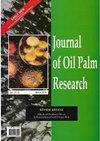摩洛哥磷矿在油棕幼苗上不同含量和类型的评价
IF 1.3
4区 农林科学
Q2 Agricultural and Biological Sciences
引用次数: 0
摘要
本文章由计算机程序翻译,如有差异,请以英文原文为准。
EVALUATION OF DIFFERENT RATES AND TYPES OF MOROCCAN PHOSPHATE ROCKS ON OIL PALM SEEDLINGS
Phosphorus (P) deficiency has consistently been a major limitation in crop production, especially in acidic tropical soils such as those in Malaysia. Since Morocco has the world’s largest reserve of phosphate mines, its phosphate rocks (PR) can be examined for their agronomic effectiveness in Malaysian soil. This study investigated the effects of various types of Moroccan phosphate rocks (MPR) as well as Egyptian phosphate rocks (EPR) on the growth performance of different oil palm genotype seedlings. Five different rates of MPR Type B was used to assess the effect of different rate of PR on oil palm seedlings’ performance; 0 mg P kg –1 (control), 50 mg P kg –1 , 100 mg P kg –1 , 200 mg P kg –1 and 400 mg P kg –1 . Meanwhile, four different types of PR were used to assess the effect of different types of PR on oil palm seedlings’ performance: MPR Type A, MPR Type B, MPR Type C, EPR and control (no PR application). The results showed that the rates and types of PR application had significant effects on the P concentration and P uptake of oil palm seedlings. MPR Type B at 100 mg P kg –1 was found to produce the optimum rate of P concentration and P uptake in the oil palm seedlings. In terms of different sources of PR, MPR Type B was found to provide oil palm seedlings with a higher concentration of P than EPR.
求助全文
通过发布文献求助,成功后即可免费获取论文全文。
去求助
来源期刊

Journal of Oil Palm Research
农林科学-食品科技
CiteScore
2.60
自引率
30.80%
发文量
69
审稿时长
>12 weeks
期刊介绍:
JOURNAL OF OIL PALM RESEARCH, an international refereed journal, carries full-length original research papers and scientific review papers on various aspects of oil palm and palm oil and other palms. It also publishes short communications, letters to editor and reviews of relevant books. JOURNAL OF OIL PALM RESEARCH is published four times per year, i.e. March, June, September and December.
 求助内容:
求助内容: 应助结果提醒方式:
应助结果提醒方式:


